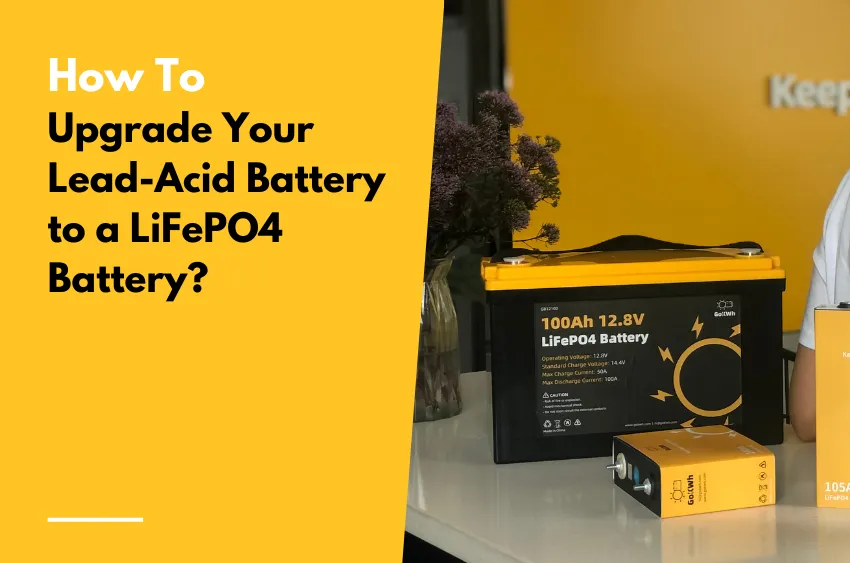Lead-acid batteries are a type of rechargeable battery that use lead and sulfuric acid as the electrodes and the electrolyte. They are widely used for various applications, such as backup power, marine, RV, and camping. However, lead-acid batteries also have many disadvantages, such as low capacity, high weight, short lifespan, and high maintenance. If you are looking for a better alternative to your lead-acid battery, you may want to consider upgrading to a LiFePO4 battery.

LiFePO4 batteries are a type of lithium-ion battery that use lithium iron phosphate as the cathode material. They have several advantages over lead-acid batteries, such as higher capacity, lower weight, longer lifespan, and lower maintenance. LiFePO4 batteries are also more environmentally friendly and safer than lead-acid batteries, as they do not contain toxic metals or corrosive acids. LiFePO4 batteries are suitable for various applications, such as backup power, marine, RV, and camping.
In this article, we will identify the reasons and the benefits of upgrading your lead-acid battery to a LiFePO4 battery, explain how to choose the right LiFePO4 battery to replace your lead-acid battery, describe how to install and connect your LiFePO4 battery to your existing system, and answer some of the frequently asked questions and address some of the common concerns and misconceptions about upgrading your lead-acid battery to a LiFePO4 battery.
There are many reasons and benefits of upgrading your lead-acid battery to a LiFePO4 battery, such as:
Higher capacity: The capacity of a battery is measured in ampere-hours (Ah) or watt-hours (Wh), and it indicates how much energy the battery can store and deliver. The higher the capacity, the longer the battery can run. However, the capacity also depends on the discharge rate and the temperature of the battery. Generally, a LiFePO4 battery can deliver 80% of its rated capacity at a 1C discharge rate (meaning the battery can be fully discharged in one hour) and at 25°C. A lead-acid battery can only deliver 50% of its rated capacity at a 1C discharge rate and at 25°C. This means that a LiFePO4 battery has a higher capacity than a lead-acid battery, by about 60%. For example, a 12V 100Ah LiFePO4 battery can power a 100W device for 12 hours, while a 12V 100Ah lead-acid battery can only power the same device for 6 hours.
Lower weight: The weight of a battery is measured in kilograms (kg) or pounds (lbs), and it indicates the mass of the battery. The weight of a battery can affect the performance, the installation, and the transportation of the battery. Generally, a LiFePO4 battery has a lower weight than a lead-acid battery, by about 70%. For example, a 12V 100Ah LiFePO4 battery weighs about 12 kg, while a 12V 100Ah lead-acid battery weighs about 40 kg. This means that a LiFePO4 battery can reduce the weight of your system, and make it easier and cheaper to install and transport.
Longer lifespan: The lifespan of a battery is the number of cycles that the battery can perform before its capacity drops to 80% of its original capacity. The lifespan of a battery depends on the type, the quality, and the usage of the battery. Generally, a LiFePO4 battery has a longer lifespan than a lead-acid battery, by about 20 times. For example, a LiFePO4 battery can last up to 10,000 cycles, while a lead-acid battery can only last up to 500 cycles. This means that a LiFePO4 battery can last longer and save you the hassle and the cost of replacing the battery frequently.
Lower maintenance: The maintenance of a battery is the amount of time, money, and effort that you need to spend to keep the battery in good condition and performance. The maintenance of a battery depends on the type, the quality, and the usage of the battery. Generally, a LiFePO4 battery has a lower maintenance than a lead-acid battery, by a significant amount. For example, a LiFePO4 battery does not need to be watered, equalized, or vented, while a lead-acid battery needs to be watered, equalized, and vented regularly. This means that a LiFePO4 battery can save you time, money, and effort on maintaining the battery.
As you can see, upgrading your lead-acid battery to a LiFePO4 battery can bring you many benefits, such as higher capacity, lower weight, longer lifespan, and lower maintenance. LiFePO4 batteries can also improve the performance and reliability of your system, and reduce the risk of failure and damage. LiFePO4 batteries can also be more environmentally friendly and safer than lead-acid batteries, as they do not contain toxic metals or corrosive acids. LiFePO4 batteries are suitable for various applications, such as backup power, marine, RV, and camping.